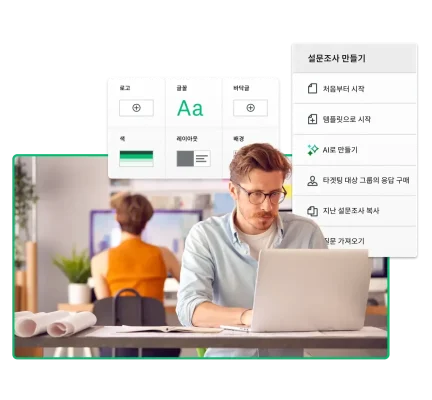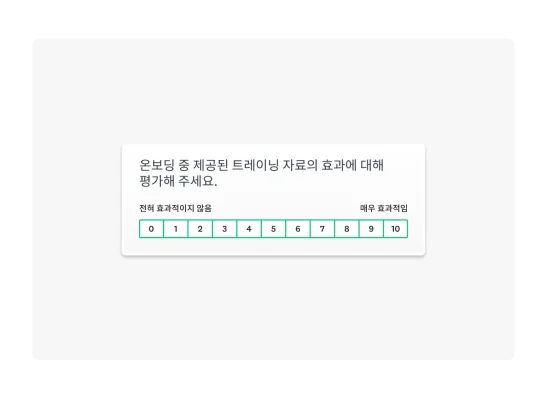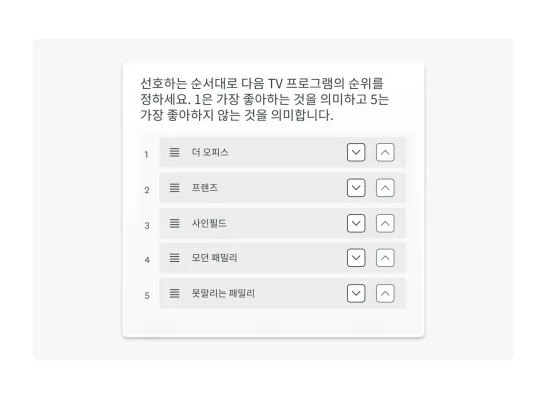
- 온라인 퀴즈를 디자인하려면 올바른 질문과 답항을 선택하고, 채점 규칙을 설정하며, 전략적으로 퀴즈를 공유해야 합니다.
- 온라인 퀴즈는 트레이닝 평가, 기술 및 역량 테스트, 학업 평가, 상식 퀴즈 또는 게임 퀴즈로 분류될 수 있습니다. 각각 학습, 기술 검증 또는 엔터테인먼트와 같은 구체적인 목표에 맞게 조정됩니다.
- 훌륭한 퀴즈 질문을 작성하려면 질문이 명확하고 간결하며 퀴즈 목표에 부합하도록 하고, 지식이나 이해도를 효과적으로 평가하기 위해 적절한 답항을 제공해야 합니다.
빠르고 쉽게 무료로 온라인 퀴즈를 만들 수 있는 방법을 찾고 계신가요? SurveyMonkey의 무료 온라인 퀴즈 작성기를 사용하면 퀴즈를 만들고 맞춤화하여 보내는 것은 물론 퀴즈 응답도 수집할 수 있습니다.
다음은 SurveyMonkey에서 퀴즈를 만들고 최대한 활용하기 위한 빠른 시작 가이드입니다. 퀴즈를 만드는 방법, 퀴즈를 효과적으로 만드는 방법, 보내는 방법 및 다양한 퀴즈 질문의 예시에 대한 인사이트를 제공합니다.
SurveyMonkey를 사용하여 퀴즈를 만드는 방법
SurveyMonkey로 아주 쉽게 온라인 퀴즈를 만들 수 있습니다. SurveyMonkey의 온라인 퀴즈 작성기를 통해 몇 분 안에 퀴즈를 만들고, 배포하고, 결과를 수집할 수 있습니다.
퀴즈 작성기 실행 방식은 다음과 같습니다.
- 무료 SurveyMonkey 계정을 만들거나 로그인하여 온라인 퀴즈 템플릿 중 하나를 선택합니다. 특정 퀴즈를 염두에 두고 있다면 ‘새로 시작하기’을 선택할 수도 있습니다.
- 빌드 기능을 사용하여 설문조사에 퀴즈 질문을 추가합니다.
- 각 질문에 ‘이 질문에 점수 매기기(퀴즈 모드 사용)’를 활성화합니다.
- 더하기 또는 빼기 기호를 사용하여 답항에 포인트를 할당합니다.
- 이메일, 소셜 미디어, 웹링크 및 모바일 채팅을 통해 퀴즈를 배포합니다.
설문조사를 퀴즈로 전환
설문조사를 만드는 데 더 익숙하다면 이 옵션을 사용하여 퀴즈를 만들 수도 있습니다. 먼저 기존 계정에 바로 로그인하거나 무료 SurveyMonkey 계정에 가입합니다. 여기에서 설문조사 만들기를 선택한 다음 새로 시작하기를 선택합니다. 빌드 버튼으로 포함하려는 텍스트를 입력하면서 설문조사에 질문을 추가할 수 있습니다.
퀴즈에서 무엇을 질문해야 할지 잘 모르겠으면 질문 은행에 있는 미리 작성된 질문을 사용해 보세요.
기존 SurveyMonkey 퀴즈 템플릿 사용
퀴즈에 무엇을 포함할지 잘 모르겠으면 언제든 SurveyMonkey 온라인 퀴즈 템플릿 중 하나를 사용하여 프로세스를 간소화할 수 있습니다. 머리글 메뉴에서 설문조사 만들기를 선택한 다음 템플릿으로 시작을 선택합니다. 드롭다운 메뉴에서 양식을 선택하여 전체 컬렉션을 살펴볼 수 있습니다.
마음에 드는 퀴즈 템플릿을 찾았으면 이 템플릿 사용을 선택합니다.
어떤 유형의 퀴즈가 있나요?
어떤 것에 대해서든 퀴즈를 만들 수 있습니다. 예를 들어 회사 법률 트레이닝 퀴즈로 직원을 테스트하는 곳도 있고, 친구들이 함께 모여 영화 및 TV 시청 설문조사를 사용하여 친구들이 무엇을 시청하고 있는지 알아보면서 재미로 퀴즈를 사용하기도 합니다.
사용할 수 있는 몇 가지 퀴즈 유형을 살펴보겠습니다.
트레이닝 평가 또는 퀴즈

신규 직원들이 순조롭게 역할에 적응하도록 돕는 온보딩 과정에서 회사 절차 및 해당 직책과 관련된 사항들을 신속하게 익히도록 여러 가지 온라인 트레이닝 코스를 이수하게 됩니다. 하지만 신규 직원들이 그 과정에서 어떻게 느끼고 있는지, 새 업무를 시작할 준비가 되었다고 느끼는지 시간을 내어 파악하는 회사들은 많지 않을 것입니다. 어떤 방법으로 파악하는 것이 좋을까요? 온보딩 설문조사 템플릿으로 평가하면 됩니다. 이 설문조사를 통해 얻는 결과로 최고의 온보딩 경험을 제공하기 위해 필요한 조정을 할 수 있습니다.
교육 모듈을 마친 후 트레이닝 평가 퀴즈를 사용하여 직원들이 트레이닝에서 배운 중요한 사항들을 기억하는지 확인해 볼 수 있습니다. 이 전략은 트레이닝 모듈 후 직원의 지식 수준을 정확히 파악하여 직원 온보딩 및 트레이닝을 간소화하는 데 도움이 됩니다. 또한 도움이 필요한 사람들에게 추가 지원을 제공할 수 있습니다.
설문조사를 통해 직원들에게 트레이닝 경험에 대한 피드백을 제공할 기회를 줄 수도 있습니다. 트레이닝 코스 평가 설문조사 템플릿에는 “이 트레이닝 세션을 동료에게 추천할 가능성은 얼마나 됩니까?”와 같은 질문이 있습니다. 피드백을 요청하고 필요한 조치를 실행해 나가면서 직원들에게 제공하는 트레이닝이 점점 개선될 것입니다.
ORA Systems는 SurveyMonkey를 사용하여 82개의 각기 다른 트레이닝 코스를 모든 직원들이 액세스할 수 있는 하나의 시스템으로 통합할 수 있었습니다. 이 회사는 SurveyMonkey의 중앙 집중식 데이터 플랫폼을 통해 트레이닝 프로그램을 쉽게 혁신하고 직원들을 더 잘 이해하는 데 필요한 분석적인 인사이트를 얻을 수 있었습니다.
기술 및 역량 테스트
테스트는 또한 많은 사람들에게 매우 익숙하고 유용한 퀴즈 형식입니다. 기업은 퀴즈를 사용하여 특정 직무를 위한 후보자들을 선별하거나 심지어는 현재 직원들을 테스트하여 직무와 관련된 특정 주제에 대한 지식을 평가할 수 있습니다.
조직은 후보자 평가 양식 템플릿을 사용하여 후보자 프로필을 통합하고 누구의 프로필이 회사에 가장 적합한지 알아볼 수 있습니다. “1~5의 척도에서 귀하의 의사소통 기술을 어떻게 평가하시겠습니까?”와 같은 질문을 통해 어떤 후보자를 인터뷰에 초대해야 할지 파악할 수 있습니다.
퀴즈는 빨리 답변할 수 있기 때문에 후보자 모집 및 현재 직원 테스트에 유용하게 사용될 수 있습니다.
온라인 교육 또는 학술
교육 또는 학술 퀴즈는 많은 사람들이 수년간 사용해 온 퀴즈 형태입니다. 교수와 교사는 퀴즈를 사용하여 학생들이 내용을 이해했는지, 수업에 필요한 자료를 읽었는지 여부를 쉽게 확인할 수 있습니다.
특히 지난 몇 년 동안 온라인 교육으로의 주요 이동을 고려하면, 온라인 퀴즈가 제공하는 간편한 배포가 매우 중요해졌습니다. 교사는 사람들에게 점수를 표시하는 기능을 사용 설정하여 학생들이 맞고 틀린 것이 무엇인지 알 수 있도록 할 수 있습니다.
SurveyMonkey는 학술 기관이 데이터를 기반으로 한 성공에 필요한 인사이트를 확보하는 데 사용할 수 있는 다양한 교육용 설문조사 및 퀴즈를 제공합니다.
단순한 재미: 상식 퀴즈 또는 게임 퀴즈

온라인 퀴즈의 또 다른 일반적인 용도는 재미를 위한 것입니다. 친구, 가족 또는 동료와 즐길 수 있는 수많은 게임 퀴즈가 있습니다. 대중 문화, 스포츠, 최근의 뉴스에 대한 지식을 묻거나 상식 퀴즈 이벤트를 주최할 수도 있습니다.
재미를 위한 퀴즈는 단순한 게임이 아니라 팀 빌딩을 위한 강력한 도구로서 팀의 참여를 장려하고, 결속력을 높이며, 팀원 간의 친밀한 관계를 형성할 수 있습니다. 퀴즈 애널리틱스를 사용하여 어떤 팀의 성적이 가장 우수한지 볼 수 있어서 집단 성취감과 동료애를 키울 수 있습니다.
퀴즈에 효과적인 질문 작성하기
흥미를 유발하는 퀴즈는 효과적인 질문에서 시작됩니다. 효과적인 퀴즈 질문을 작성하려면 다음 가이드라인을 따라야 합니다.
- 간단하게 유지: 누구도 긴 퀴즈 질문을 읽는 것을 원하지 않습니다. 간결하고 요점에 맞게 질문을 작성하세요. 질문이 짧을수록 질문이 애매해지지 않아 응답률을 높이는 데도 도움이 됩니다.
- 다양한 답항 사용: 모든 사람을 위한 답항을 퀴즈에 포함하는 것을 목표로 해야 합니다. 선택할 수 있는 답항을 다양하게 제공하여 응답자들이 대충 비슷한 답항에 만족하는 대신 정확하게 원하는 답항을 찾을 수 있도록 해야 합니다.
- 유도 질문 및 함축적 질문 피하기: 유도 질문 및 함축적 질문은 퀴즈 답변자들이 특정 방식으로 응답하도록 강요합니다. 이런 접근 방식은 퀴즈의 신빙성을 손상시키고 결과를 왜곡할 수 있습니다.
- 질문 카운터 포함: 사람들이 퀴즈에 소요되는 시간을 모르면 퀴즈 질문에 답변하는 데 지칠 수 있습니다. 질문과 함께 카운터를 포함하여 퀴즈의 진행률을 보여주세요.
퀴즈 질문 작성에 대한 보다 종합적인 가이드를 찾고 있다면 설문조사 질문 디자인에 대한 웨비나를 시청하여 전체 인사이트를 확인하세요.
온라인 퀴즈: 팁 및 모범 사례
온라인으로 퀴즈를 보내면 접근성을 높이는 데 도움이 되어 더 많은 응답과 더 정확한 최종 결과로 이어집니다.
다음은 응답률을 높이고 데이터 품질을 개선하기 위한 팁을 포함하여 온라인 퀴즈에 대한 몇 가지 모범 사례입니다.
정확한 채점을 위해 선별 질문 사용
선별 질문은 퀴즈 응답자가 퀴즈에 적합한 사람인지 여부를 결정하는 데 도움이 되는 퀴즈 전 질문입니다. 특정 그룹의 사람들을 대상으로 하고 싶다면 선별 질문을 사용하여 적합한 사람들만 퀴즈에 응답하도록 할 수 있습니다.
사용할 수 있는 퀴즈 선별 질문에는 행동 선별 질문과 업계별 선별 질문의 두 가지 주요 유형이 있습니다. 행동 선별 질문은 읽기 습관에 대한 설문 전에 '일주일에 몇 시간이나 책을 읽으십니까?'라고 묻는 것과 같이 사람들의 행동과 관련이 있습니다. 0으로 답변한 사람은 부적격자이므로 설문조사에 응답할 수 없을 것입니다.
업계별 선별 질문은 어떤 업계에 종사하거나 어떤 직책을 맡고 있는지에 대해 묻습니다. 예를 들어 조직에서 고객 서비스 기술에 대한 퀴즈를 진행하고 있다면 고객과 연락하지 않는 직원에게 퀴즈를 낼 필요가 없습니다. 선별 질문은 퀴즈가 적용되지 않는 사람들을 가려내는 데 도움이 됩니다.
선별 질문을 사용하면 최종 데이터의 정확성을 최대한 보장하면서 연관성이 없는 퀴즈로 사람들의 시간을 뺏지 않습니다.
관련 문서: 설문조사에서 선별 질문을 사용하기 위한 5가지 팁.
올바른 퀴즈 질문 유형 선택
올바른 퀴즈 질문 유형을 결정하는 유용한 방법은 성취하려는 결과를 고려하는 것입니다. 어떤 퀴즈는 퀴즈 응답자들에게 정답을 보여주지만, 어떤 퀴즈는 회사에서 사용할 데이터만 생성합니다.
관련 문서: 설문조사 질문 유형: 전문가의 팁과 예.
응답자들에게 바로 점수 공개
대부분의 응답자들은 퀴즈의 정답을 확인하기 위해 기다리고 싶어 하지 않습니다. 시간을 내어 퀴즈를 풀었다면 가능한 한 빨리 결과를 보고 싶을 것입니다. SurveyMonkey 퀴즈를 사용하면 응답자들이 질문을 마치는 즉시 정답과 오답을 확인하도록 할 수 있습니다. 실행하려는 퀴즈 유형에 따라 이 옵션의 사용을 선택할 수 있습니다.
어떤 경우에는 반드시 퀴즈 응답자들에게 점수를 공개해야 합니다. 예를 들어 학생들은 가능한 한 빨리 점수를 알고 싶을 것입니다.
자주 묻는 질문
- 새 퀴즈를 만들려면 어떻게 해야 하나요?
- 훌륭한 퀴즈의 조건은 무엇인가요?
- 무료 온라인 퀴즈를 만드는 데 가장 좋은 도구는 무엇인가요?
SurveyMonkey로 신속하게 온라인 퀴즈 만들기
온라인 퀴즈는 기술, 역량을 테스트하거나 즐거운 시간을 갖기 위한 쉬운 방법입니다. 채용을 위해 후보자에게 직무에 대한 질문을 하든, 학생이나 직원의 참여도를 높이고자 하든, 퀴즈는 강력한 도구입니다.
무료 온라인 퀴즈를 만드는 가장 좋은 도구는 자동 채점, 퀴즈 템플릿, 간편한 배포 방법, 효과적인 데이터 수집 및 분석 기능을 포함해야 합니다. SurveyMonkey는 이 모든 것을 갖추었을 뿐만 아니라 몇 분 안에 퀴즈를 만들고 공유할 수 있습니다.
지금 퀴즈를 시작해 보세요.
시작할 준비가 되셨습니까?
Discover more resources

역할에 맞는 솔루션
SurveyMonkey로 업무 효율성을 높일 수 있습니다. 성공적인 전략, 제품, 경험 등으로 더 큰 효과를 거둘 수 있는 방법을 알아보세요.

설문조사
전문가가 작성한 400개 이상의 맞춤형 설문조사 템플릿을 둘러보세요. SurveyMonkey로 관심을 끄는 설문조사를 신속하게 만들어 보내세요.

퇴사자 인터뷰 양식을 만들어 개선이 필요한 영역 파악
퇴사자 인터뷰 설문조사에서 올바른 질문을 하여 직원 감소율을 낮추세요. 직원 양식 작성기 도구와 템플릿으로 지금 시작하세요.

온라인 동의서 양식으로 필요한 허가를 받으세요
쉽게 동의서 양식을 만들고 맞춤화하세요. 안전하고 사용하기 쉬운 양식 작성기로 전자 서명을 받고, 규정 준수를 보장하며, 워크플로를 간소화하세요.